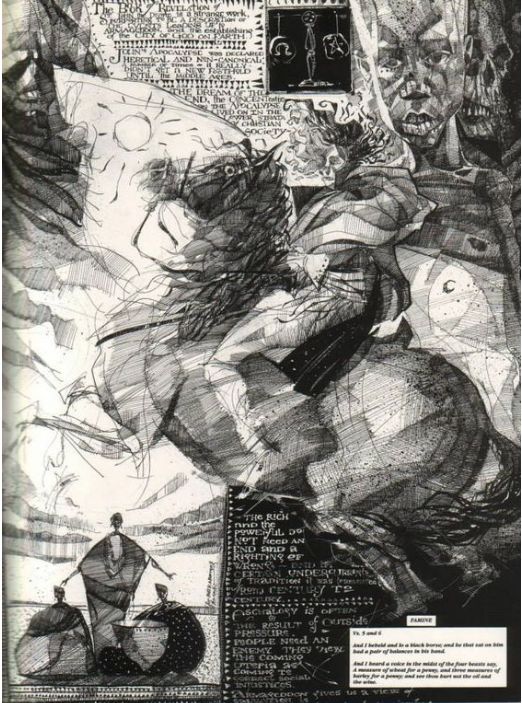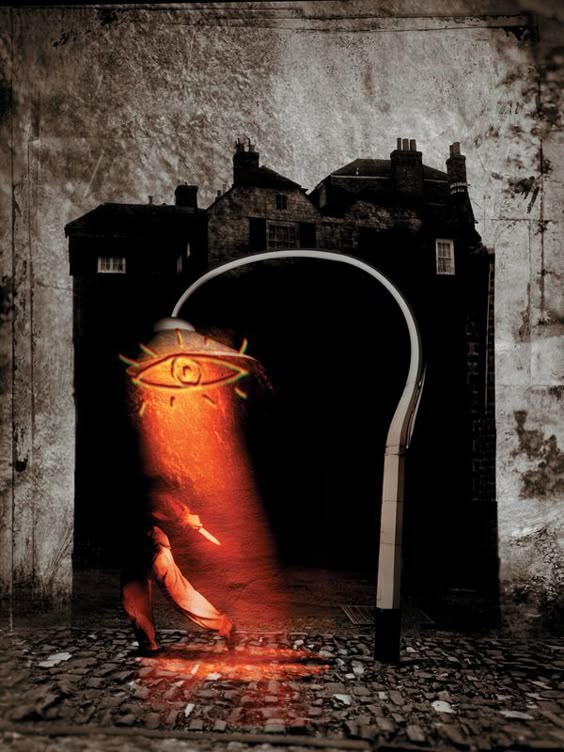I continue to experiment and learn as I work on my historical survey of surrealism, and my project grows. What I'd first planned as a simple accordion-style book has turned into a piece of assemblage art. While researching the games and exercises played and implemented by surrealists, I reacquainted myself with Exquisite Corpse, a game I've frequently played throughout my life in visual and textual formats. I realized that the accordion book format is an ideal way to utilize exquisite corpse while simultaneously offering up a cross-selection of drawing styles inspired by various surrealists.
Exquisite corpse, originally called
cadavre exquis,
"embodied the surrealist notions of collaboration and chance. Derived in part from a parlor game and in part from a dada game called Little Papers, in which poems were composed from randomly chosen words, the exquisite corpse was "discovered" by the surrealists in 1925 "on one of those idle, weary nights" at the residence of Tanguy, Jacques Prévert, and Marcel Duhamel at 54 rue du Chateau. Acording to Breton, a frequent "player": "What really excited us about these productions was the certainty that, no matter what, they could not possibly have been onjured up by a single brain, and that they possessed to a much greater degree the capacity for 'deviation.'
"Indeed the game's resulting images, which nearly always were anthropomorphic given the seeming preference for the vertical orientation and head-to-toe sequencing, evoke fantastic and often grotesque creatures that defy logical explanation. Since it involved chance and collaboration, the exquisite corpse separated (or at least distanced) the individual player/artist/writer from his or her creative will. And anyone could play. Certainly the naiveté of nonartists would have been welcomed in a circle in which innocence and artlessness were esteemed. But it was not all fun and games, as pointed out by Simone Kahn, Breton's first wife and frequent exquisite corpse collaborator: it was "a method of research, a way to exaltation and stimulation, a mine of numberless inventions, a drug perhaps." Bizarre creatures such as those generated via the exquisite corpse do seem to reappear in artists' individual works, most notably in Victor Brauner's mechanomorphic figures and in the quasi-totemic configurations of Wifredo (sic) Lam.
"The vast number of existing exquisite corpses, executed in a variety of media and types over many years, attest to their addictive quality. The earliest examples were drawn with graphite or ink or colored pencil on common everyday writing paper. Around 1929 to 1930, collaborators began using pastel or tempera on black paper, but because of the paper's fragility, it was often not folded. Instead, small marks to the left and/or right of the sheet indicate the divisions, or registers, of the exquisite corpse. Areas not being drawn were then covered by another sheet of paper to guarantee the chance results" (Jones L., 2012, pp. 31-32).
"
Cadavre exquis drawings were inspired by an old parlour game. One evening at 54 rue du Chateau, a Surrealist meeting place in Paris between 1924-8, Jacques Prévert wrote on a piece of paper "Le cadavre exquis," folded the paper, and passed it around the room for others to write the words in their minds. The result was the powerful sentence "le cadavre exquis boira le vin nouveau" which astounded those present . Another night, they tried using imagery: one artist would draw three or four lines which would extend beyond the fold, and the next person would continue the lines until shapes emerged. Finally, this game was played by simply covering areas of the sheet.... The final result was a composition of interconnected images derived from the subconscious ideas of the artists. Simone Kahn wrote that the final results of this practice were 'creatures none of us had foreseen'" (from the Research Report for
Cadavre Exquis c. 1931 obtained at
The Marvin Gelber Print and Drawing Study Centre, AGO).
I chose to incorporate a cross-selections of paintings and drawings for this exquisite corpse method of delivery. The order of influences goes as follows:
- A drawing inspired by René Magritte's The Son of Man
- H. R. Giger's illustration for the cover of Danzig's album How the Gods Kill
- Marion Adnam's L' Infante Egaree
- Bridget Bate Tachenor's Velador
- Roberto Matta's drawing for Les Chants de Maldoror
- Giorgio de Chiroco's Two Mannequin Heads
- Salvador Dali's Venus With Drawers
- Hans Bellmer's La Poupée
Aside from searching online and in libraries for information pertinent to surrealism, I also travelled to Toronto on several occasions to visit the AGO. I took photographs and made sketches of original works at the Guillermo del Toro exhibition, and also visited
The Marvin Gelber Print and Drawing Study Centre, AGO. There I spoke with the curator of the studio about my interest, and with the assistance of the archivists, was able to study two remarkable pieces up close and personal.
The first piece I studied is an example of
cadavre exquis. It was created by Valentine Hugo, Tristan Tzara, Yves Tanguy, Paul Eluard, and Nusch Eluard circa 1931. This is a fascinating piece, not only to look at, but also from a historical perspective. It is a rare piece, as only a few were executed on black paper. The inscription on the reverse indicated which images each artist made. Valentine Hugo did the writing and the bird's head. Tzara drew the scissors. Tanguy drew the cliff and chameleon. Paul and Nusch Eluard did the rest.

The second piece I studied in detail is
Two Mannequin Heads by Giorgio de Chirico. This drawing fascinated me because it is much more mechanical-looking than the majority of pieces I've studied by other surrealists. It is a beautiful drawing with excellent lines, and I decided to incorporate elements of it in my exquisite corpse study.

I want to go with the working title
Body of Work. The play on words references Exquisite Corpse, the surrealists' fascination with the body, as well as the body of work put out by the surrealist movement. I have been looking at surrealists from around the world, and have been working at getting a good cross-selection of international artists. I have also been researching female surrealists, since men are more heavily represented in studies despite there having been plenty of highly-skilled and esteemed women within the movement. Some of the artists did not call themselves surrealists, but were claimed by the movement (eg. Frida Kahlo). Some dissociated themselves from the movement, but are surrealists nonetheless (eg. Salvador Dali).
With my research, I have expanded my original concept to something larger than just a book. I am creating a box to contain the book. The box contains elements of other surrealists.
I was inspired by the three-dimensional work of Méret Oppenheim, a surrealist more famous because she modelled for Man Ray than she is famous for her own works. This is unfortunate, as she was a skilled and imaginative artist in her own right. She created a fur-covered cup and saucer, and also made a diorama including feathers. I followed her influence to make an inset in my box including feathers.
Another part of the box incorporates elements of cut-up poetry. Tristan Tzara, who I discovered courtesy of the Exquisite Corpse, is considered to have been the progenitor of cut-up poetry. In 1920, "Tristan Tzara publishes 'To Make a Dadaist Poem' which instructs the reader to cut out words from a newspaper article, put them in a bag, shake, and then remove individually and compose a poem ' conscientiously in the order in which they left the bag'" (Jones, 2012, p. 63). I used this inspiration to create a poem, and combined it with collage.
The outside of the box is découpaged to continue with the surrealist theme of collage.
Jones, Leslie.
Drawing Surrealism. Los Angeles, CA : Los Angeles County Museum of Art, [2012]. from pp 31-32
























![[Violent Cases]](https://i.pinimg.com/564x/c8/73/e8/c873e89737483293e19c1a0c69f77461.jpg)


![[Sandman cover]](https://i.pinimg.com/564x/4a/ef/8b/4aef8bd68cbd980620e6bae197a63451.jpg)
![[Neil Gaiman]](https://i.pinimg.com/564x/5d/f4/44/5df44494e3e30528cc800374d39a62ef.jpg)


![[BRAP]](https://i.pinimg.com/564x/57/e7/ad/57e7ad81dc45808dc096796217a05533.jpg)

![[Wolves in the Walls]](https://i.pinimg.com/564x/ff/aa/aa/ffaaaae8aa18e524688d9ddbde34588a.jpg)
![[Mirrormask]](https://i.pinimg.com/564x/6c/8d/30/6c8d3073c1dcd18ae7214a3f08975fcc.jpg)
![[Jackass]](https://p.dreamwidth.org/dbd841eef11d/3289137-10349/i205.photobucket.com/albums/bb194/shanmonster/jackass.jpg?t=1516399241)

